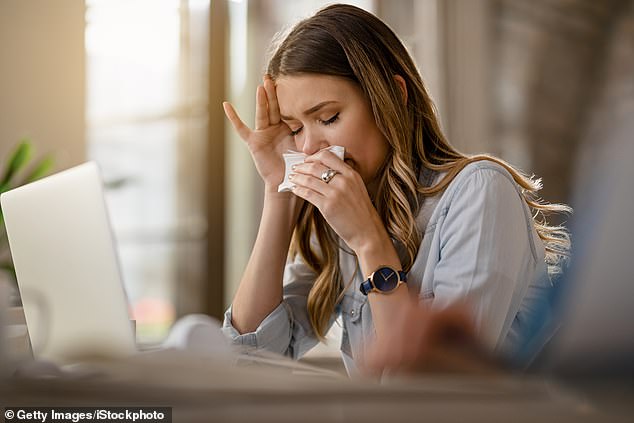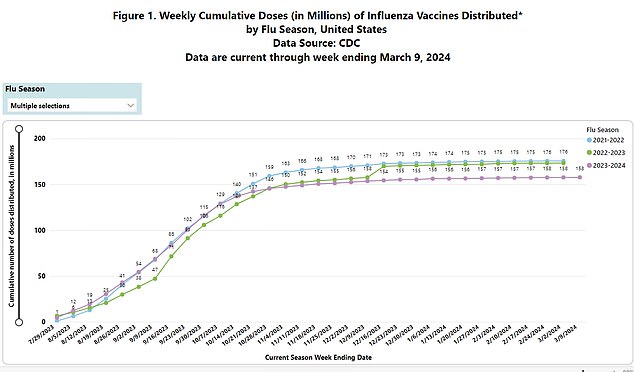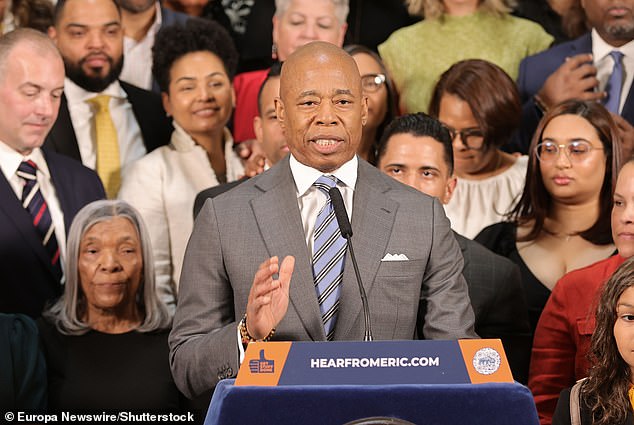The summer heat has barely begun to subside, but across the country people are falling ill with symptoms normally reserved for winter.
If you’ve noticed waves of colleagues out sick or in the office with coughs, runny noses and fatigue, you’re not alone.
The United States is once again reporting elevated levels of COVID-19 after a record-breaking summer for the disease, which affected everyone from President Biden to New York City Mayor Eric Adams.
And a perfect storm of low immunity due to lockdowns and social distancing combined with low vaccination rates means older viruses are causing more severe illness, extending beyond the normal cold and flu season.
New York City Mayor Eric Adams tested positive for the Covid virus in September 2024. He is one of 16 percent of people who have tested positive for the disease, according to CDC data.

President Biden tested positive for Covid shortly after his debate with former President Trump, at the start of the summer coronavirus surge
Dr Eve Elizabeth Pennie, a GP and DrugWatch contributor, told DailyMail.com: “It definitely seems like more people are getting sick lately, and there’s a good reason for that.”
Dr Pennie explained that the lockdowns of 2020 and 2021 disrupted the seasonal patterns of colds and flu, meaning people were not exposed to the virus for a long period of time.
This means that when people returned to their normal lives, their immune systems were weaker and contact with these viruses made them sicker than they should have been.
Dr Pennie added: “This means more people are getting sick as our bodies readjust.”
Now, as people adjust to the new normal, COVID is becoming more contagious as it evolves from person to person and there is still a gap in the number of people getting vaccinated.
This, combined with more opportunities for disease to spread as children return to school and workers return to the office after vacation, is leading to an increase in illness, Dr. Vin Gupta, a pulmonologist and chief medical officer at Amazon Pharmacy, told DailyMail.com.
Dr. Gupta said: “Late summer and early fall are really interesting times for the spread of infectious diseases… There are all kinds of mixes.”
National monitoring of wastewater shows that circulating levels of COVID-19 virus are currently “high,” particularly in the West and Midwest, in states such as California, Nevada, Illinois and Kansas.
This month, the CDC reported that the percentage of all people who got a COVID test and tested positive for the virus reached 16.3 percent.
This represents an increase from historical rates. July 2020, 7.5 percent of people tested positive for the virus.
Still, the virus has become less deadly over time, thanks in part to new treatments and vaccines. But because people are living with the disease, they can spread it more easily.
And as the disease spreads from person to person, it also evolves to become more contagious. Dr. Gupta said, “I’m concerned that we’ve entered a space where we have a number of threats that seem to be evolving rapidly.”
But right now, it’s not just COVID, doctors said. This season, the cold, flu, H1N1 and other viruses, such as respiratory syncytial virus, have been circulating, Dr. Pennie said, harassing people’s already battered immune systems.
Searches for the phrase “common cold” have also been steadily increasing over the summer, peaking today. Similarly, searches for “Do I have the flu?” have also seen ups and downs over the summer months, reaching a more consistent increase starting on August 29.
This is because the virus is evolving and becoming more and more contagious, Dr. Gupta said.
There were an estimated 1,565 COVID deaths in the U.S. in the last half of August, According to the Centers for Disease Control and Prevention.
Dr Gupta said: “It’s a big problem and I suspect that number is going to increase significantly as we get into the depths of winter.”
Add to that a flu season that I suspect will continue to be worse than the pre-pandemic average, because fewer people are getting vaccinated against everything.
COVID-19 has also impacted the severity of the cold and flu season. Getting sick with one of these viruses increases the likelihood of getting sick with another virus or bacteria. This, in turn, increases the likelihood of getting seriously ill.
Dr Pennie said: “The pandemic changed the way we interact with viruses. During the COVID-19 pandemic, wearing masks and social distancing dramatically reduced the spread of the common cold and flu viruses.

Immunization rates have generally declined since the pandemic, making people more susceptible to common viruses. Plus, getting sick with one of these germs can weaken the immune system, making you more likely to get a different illness, creating an “additive effect,” Dr. Gupta said.
But now that those measures have been relaxed, viruses are returning at different times of the year and sometimes in stronger waves.
Moreover, since the pandemic, widespread reluctance to get vaccinated appears to have increased.
Actual rates are difficult to estimate, but Researchers at the University of Chicago said Between 15 and 46 percent of American adults are likely hesitant to get the COVID vaccine and booster doses, and may have similar attitudes toward other vaccines.
This suggests that people may also stop getting vaccines long considered safe and effective, such as those for influenza and whooping cough, Dr. Gupta said.
CDC data shows that vaccination Flu rates have been consistently lower in 2024 than in the previous three years.
In the 2021-2022 flu season, 176 million doses of flu vaccine were distributed, but in the 2023-2024 season, 158 million vaccines were distributed.
At this time, overall flu rates are low: an estimated 168 Americans are affected. So far, there have been 35 million cases400,000 hospitalizations and 25,000 deaths.
This figure is higher than that of the 2021-2022 season, when some lockdowns were still in place and total cases were estimated by CDC to approach 9.4 millionThere were 74,000 hospitalizations and around 5,000 deaths.
There has also been a rise in questions about vaccines required in public schools in some states, including those against whooping cough, the virus behind whooping cough.
The disease was nearly eradicated thanks to a vaccine created in the 1940s, but has been devastating communities in recent years since vaccination rates were relaxed.

CDC’s distributed flu vaccine doses show flu virus rates, as reported by private manufacturers
In Idaho, approximately 81 percent of kindergartners met federal public school vaccination requirements during the 2022-2023 school year—the lowest percentage in the country, where the average rate is 93 percent.
In Alaska, about 1,200 students out of a total of 44,000 have requested vaccination exemptions.
As a result, both states are now facing outbreaks of whooping cough so severe that they have killed an infant.
Nationwide, this means that whooping cough case rates in one week in August were four times higher than last year.
Vaccines work by introducing a bit of a damaged or fragmented virus into your body, teaching your immune system to watch out for that particular invader, so it can fight it off more easily.
Vaccination doesn’t always prevent people from getting a virus, but it does help people get less sick overall, Dr. Gupta said, and is widely considered safe.
This year, the CDC recommended that everyone six months and older get vaccinated against flu and COVID by the end of October.
This year, the flu virus protects against three different strains. The Mayo Clinic recommends getting a flu vaccine before the end of October; pregnant women and children under nine years of age may benefit from getting the vaccine earlier.
“Timing depends on your personal risk factors and what’s happening in your community, but getting vaccinated early can provide crucial protection as the virus season begins,” Dr. Pennie said.
In addition to immunization, Dr. Pennie recommends staying hydrated and getting plenty of rest, washing your hands regularly and wearing a mask, if you feel comfortable doing so, in high-traffic areas where sick people may be present.

